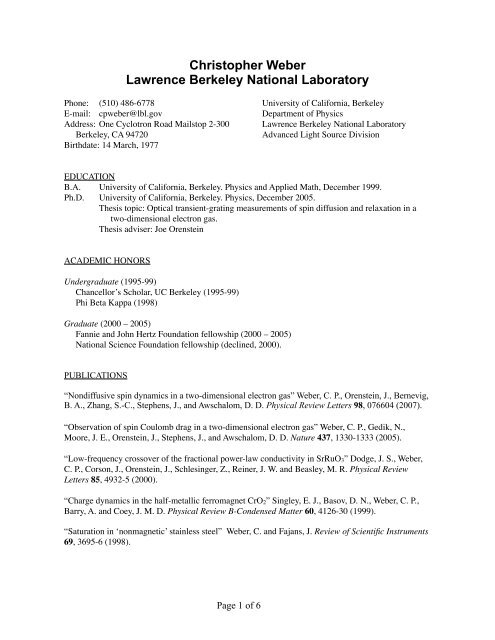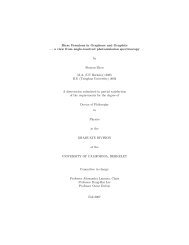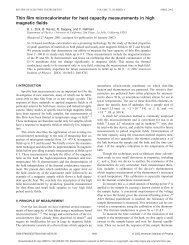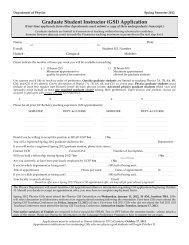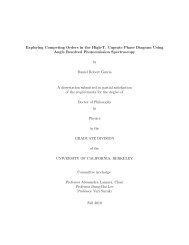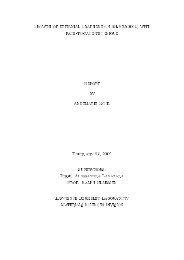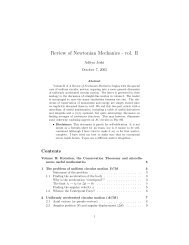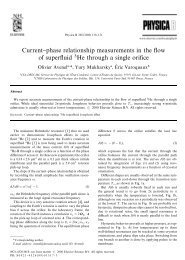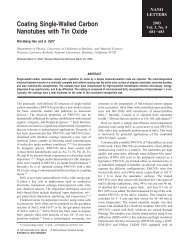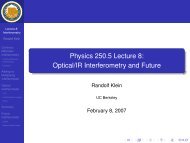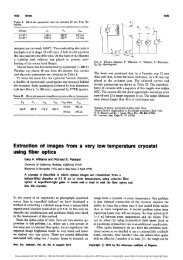Christopher Weber Lawrence Berkeley National Laboratory
Christopher Weber Lawrence Berkeley National Laboratory
Christopher Weber Lawrence Berkeley National Laboratory
You also want an ePaper? Increase the reach of your titles
YUMPU automatically turns print PDFs into web optimized ePapers that Google loves.
<strong>Christopher</strong> <strong>Weber</strong><br />
<strong>Lawrence</strong> <strong>Berkeley</strong> <strong>National</strong> <strong>Laboratory</strong><br />
Phone: (510) 486-6778 University of California, <strong>Berkeley</strong><br />
E-mail: cpweber@lbl.gov Department of Physics<br />
Address: One Cyclotron Road Mailstop 2-300 <strong>Lawrence</strong> <strong>Berkeley</strong> <strong>National</strong> <strong>Laboratory</strong><br />
<strong>Berkeley</strong>, CA 94720 Advanced Light Source Division<br />
Birthdate: 14 March, 1977<br />
EDUCATION<br />
B.A. University of California, <strong>Berkeley</strong>. Physics and Applied Math, December 1999.<br />
Ph.D. University of California, <strong>Berkeley</strong>. Physics, December 2005.<br />
Thesis topic: Optical transient-grating measurements of spin diffusion and relaxation in a<br />
two-dimensional electron gas.<br />
Thesis adviser: Joe Orenstein<br />
ACADEMIC HONORS<br />
Undergraduate (1995-99)<br />
Chancellor’s Scholar, UC <strong>Berkeley</strong> (1995-99)<br />
Phi Beta Kappa (1998)<br />
Graduate (2000 – 2005)<br />
Fannie and John Hertz Foundation fellowship (2000 – 2005)<br />
<strong>National</strong> Science Foundation fellowship (declined, 2000).<br />
PUBLICATIONS<br />
“Nondiffusive spin dynamics in a two-dimensional electron gas” <strong>Weber</strong>, C. P., Orenstein, J., Bernevig,<br />
B. A., Zhang, S.-C., Stephens, J., and Awschalom, D. D. Physical Review Letters 98, 076604 (2007).<br />
“Observation of spin Coulomb drag in a two-dimensional electron gas” <strong>Weber</strong>, C. P., Gedik, N.,<br />
Moore, J. E., Orenstein, J., Stephens, J., and Awschalom, D. D. Nature 437, 1330-1333 (2005).<br />
“Low-frequency crossover of the fractional power-law conductivity in SrRuO3” Dodge, J. S., <strong>Weber</strong>,<br />
C. P., Corson, J., Orenstein, J., Schlesinger, Z., Reiner, J. W. and Beasley, M. R. Physical Review<br />
Letters 85, 4932-5 (2000).<br />
“Charge dynamics in the half-metallic ferromagnet CrO2” Singley, E. J., Basov, D. N., <strong>Weber</strong>, C. P.,<br />
Barry, A. and Coey, J. M. D. Physical Review B-Condensed Matter 60, 4126-30 (1999).<br />
“Saturation in ‘nonmagnetic’ stainless steel” <strong>Weber</strong>, C. and Fajans, J. Review of Scientific Instruments<br />
69, 3695-6 (1998).<br />
Page 1 of 6
RESEARCH ACCOMPLISHMENTS<br />
Observation of spin Coulomb drag with Professor Joe Orenstein, modifying previous work by Nuh<br />
Gedik. (Collaborators Joel Moore at UC <strong>Berkeley</strong>, Jason Stephens and David Awschalom at UC Santa<br />
Barbara.)<br />
I devised an optical transient-spin-grating experiment to measure diffusion (DS) and lifetime of<br />
electronic spins. I developed rapid-scanned heterodyne detection that improved signal-to-noise and<br />
ease of measurement over previous transient-grating experiments, allowing us to increase the number<br />
of measurements of DS by two orders of magnitude. We discovered that DS in n-GaAs quantum wells<br />
is strongly suppressed relative to DCharge. Over a broad range of temperatures and dopings, this<br />
suppression agrees quantitatively with the prediction of “spin Coulomb drag” (SCD) theory, which<br />
takes into account electron-electron collisions’ exchange of momentum between up and down spin<br />
populations. This observation invalidates the widely held assumption that e-e collisions do not affect<br />
spin currents. Moreover, SCD increases the distance that a spin packet can be dragged in an electric<br />
field, and so provides a principle for design of spin-based electronics: materials with strong e-e<br />
scattering will be best for propagation of spin information.<br />
Giant enhancement of spin lifetime for propagation at a finite wavevector with Professor Joe<br />
Orenstein. (Collaborators Andrei Bernevig and Shoucheng Zhang at Stanford, Jason Stephens and<br />
David Awschalom at UC Santa Barbara.)<br />
In GaAs quantum wells, spin-orbit coupling of the Dresselhaus and Rashba types causes dephasing<br />
of spin populations by correlating an electron’s precession with the path of its random motion in 2-D.<br />
However, when the two coupling strengths are equal, propagation along one crystal axis (x) mimics<br />
propagation in a 1-D channel—an electron’s precession is proportional to its net displacement along x,<br />
and the spin lifetime is predicted to diverge. Using an optical transient-spin-grating experiment, I<br />
measured the spin-grating lifetime, as a function of wavevector, q, of n-GaAs quantum wells with<br />
nearly equal Dresselhaus and Rashba couplings. Lifetimes for q directed along x were enhanced<br />
relative to those along y, and relative to the spin-polarization lifetime (q=0). At the q corresponding to<br />
the spin-orbit precession length, the spin-grating lifetime is more than 10 times the spin-polarization<br />
lifetime. This observation supports the possibility of strongly modulating spin lifetimes with a gatecontrolled<br />
Rashba coupling, as in a recently proposed concept for a nonbalistic spin-field-effect<br />
transistor (Schliemann et al., PRL 90 146801).<br />
CURRENT RESEARCH<br />
Ultrafast x-ray absorption spectroscopy of condensed matter and warm, dense matter with Professor<br />
Roger Falcone and Dr. Phil Heimann.<br />
At beamline 6 of the Advanced Light Source, an amplified femtosecond laser system is<br />
synchronized with soft- and hard-x-ray synchrotron radiation for pump-probe experiments. Our<br />
experiments probe materials with mean energies of a few eV: the “warm, dense matter” (WDM)<br />
regime, which lies between those of condensed matter and strongly-coupled plasmas. Material<br />
properties in this regime are largely unknown; and because many experiments creating WDM create a<br />
short-lived, nonequilibrium state, probing the ultrafast dynamics of this state is particularly important.<br />
We create WDM from thin foils through the absorption of a short pulse of light containing several<br />
milijoules of energy. This laser pulse is overlapped at the foil in time and space with a broadband x-ray<br />
pulse. The transmitted x-rays are dispersed for ~1 eV resolution and swept to picosecond resolution by<br />
an x-ray streak camera, giving a near-edge x-ray absorption spectrum of the WDM before it melts or<br />
ablates.<br />
We also hope to measure condensed matter. In a proposed experiment, we may collaborate with UC<br />
<strong>Berkeley</strong> scientists to use ultrafast hard x-ray diffraction measure phonon propagation at room<br />
temperature in semiconductor nanowires.<br />
Page 2 of 6
SCIENTIFIC SKILLS<br />
My scientific skills include deep experience of a variety of widely applicable optical probes.<br />
Ultrafast optical spectroscopy<br />
• Pump-probe spectroscopy<br />
• Picosecond transient-grating spectroscopy<br />
• Magneto-optical Kerr effect<br />
Fourier-transform infrared spectroscopy<br />
• Transmission and calibrated-reflection geometries<br />
• Frequencies from 1 THz to near-UV<br />
Laser optics<br />
• Use and maintenance of Ar-ion laser (single- and multiple-line)<br />
• Use, assembly (from a kit), and maintenance of mode-locked Ti:Sapph (ultrafast) laser<br />
• Chirped-pulse amplification for high-energy ultrafast pulses<br />
• Frequency doubling and tripling<br />
• Laser safety<br />
X-ray spectroscopy<br />
• Soft x-ray absorption spectroscopy of condensed-matter systems<br />
• Use and design of x-ray streak camera for picosecond and eV resolution<br />
• Laser / x-ray synchronization for ultrafast spectroscopy<br />
<strong>Laboratory</strong> skills<br />
• Control of equipment and automation of data collection via IEEE-488 interface<br />
• Cryogenics<br />
• Experimental design of optics for manipulation of optical polarization<br />
• Use of sensitive optical detectors, both cooled and room-temperature<br />
• Mechanical polishing and chemical etching of semiconductors<br />
• Transient photoconductivity at low temperature<br />
Other skills<br />
• Data analysis in Matlab ®<br />
• Understanding, modeling, and fitting of large, complex sets of data<br />
COMMUNICATING SCIENCE (please also see my teaching statement)<br />
Academic Talent Search: The ATS at California State University, Sacramento, offers summer courses<br />
to advanced students from 6 th to 9 th grades. For two summers I taught an introductory optics course,<br />
which emphasized hands-on experiments. The course also included lectures, homework assignments,<br />
and tests, often focusing on the physical basis of common phenomena such as mirages or the color of<br />
sunsets. The course covers geometric optics, optical devices, color, and vision. The text was Paul<br />
Hewitt’s Conceptual Physics.<br />
Physics Scholars Program: PSP, funded by the <strong>National</strong> Science Foundation California Alliance for<br />
Minority Participation program, is a UC-<strong>Berkeley</strong>-based program that focuses on helping students<br />
from underrepresented groups to continue studying the physical sciences and engineering. Students<br />
Page 3 of 6
enrolled in introductory physics classes are offered increased individual attention and small-group<br />
discussion sections that emphasize exploratory problem-solving. I taught for PSP for two semesters as<br />
a group tutor and for one semester as a graduate student instructor.<br />
Center for Science and Engineering Education: CSEE is an outreach program of <strong>Lawrence</strong> <strong>Berkeley</strong><br />
<strong>Laboratory</strong>. Elementary-school classes are brought to the lab (or lab volunteers visit their classrooms)<br />
for hands-on lessons and demonstrations in physical science. The lessons are structured around<br />
students’ exploratory learning. Many of the students come from groups underrepresented in science,<br />
from schools in <strong>Berkeley</strong> and in the poorer cities of Oakland and Richmond. I only recently (in Fall of<br />
2007) began volunteering with CSEE.<br />
<strong>Berkeley</strong> Science Review: The BSR is a newsmagazine that presents scientific research done at UC<br />
<strong>Berkeley</strong> accessibly and interestingly to the educated lay reader. It is written and edited by <strong>Berkeley</strong><br />
graduate students. I served as an editor for three issues (18 months), and contributed several articles.<br />
See http://sciencereview.berkeley.edu.<br />
Popular Science Articles<br />
“The Health of Nations: Open-source research and the economics of life and death in the developing<br />
world,” with Audrey M. Huang. <strong>Berkeley</strong> Science Review Issue 7, Fall 2004.<br />
“Ghost Detectors in the Sky” <strong>Berkeley</strong> Science Review Issue 6, Spring 2004.<br />
“Goodbye, Cyclotron Road?” and “Vanishing Polar Bears” <strong>Berkeley</strong> Science Review Issue 5, Fall<br />
2003.<br />
“Superconducting Vinaigrette” <strong>Berkeley</strong> Science Review Issue 4, Spring 2003.<br />
PROFESSIONAL EMPLOYMENT<br />
Summers 1997, 1998: Research assistant, UC San Diego. Measured infrared reflectivity of high-TC<br />
superconductors. Supervisor: Professor Dimitri Basov.<br />
Summers 1999, 2000: Teacher, California State University, Sacramento, Academic Talent Search<br />
program. Taught introductory optics to students from 6 th to 9 th grades. Emphasized hands-on<br />
experiments. Supervisor: Dr. Terry Thomas.<br />
May 1999 – August 2000: Research assistant, <strong>Lawrence</strong> <strong>Berkeley</strong> <strong>National</strong> <strong>Laboratory</strong>, Materials<br />
Science Division. Infrared measurements of correlated-electron materials. Supervisor: Professor<br />
Joe Orenstein.<br />
March 2003 – August 2004: Member of the editorial board of the <strong>Berkeley</strong> Science Review (see<br />
above). Evaluated story “pitches” for scientific and journalistic merit and worked closely with<br />
authors on the preparation of final manuscripts.<br />
September 2004 – May 2005: Group tutor, Physics Scholars Program, UC <strong>Berkeley</strong>. Taught physics<br />
skills in introductory Newtonian mechanics to science & engineering majors. The program focuses<br />
on helping students from underrepresented groups to continue studying the physical sciences.<br />
Supervisor: Dr. Arja McCray.<br />
August 2000 – December 2005: Graduate research assistant and Hertz Foundation fellow, UC<br />
<strong>Berkeley</strong>, Department of Physics. Supervisor: Professor Joe Orenstein.<br />
Page 4 of 6
August 2005 – December 2005: Graduate student instructor, Physics Scholars Program (see above),<br />
UC <strong>Berkeley</strong>. Taught physics and laboratory skills in introductory thermodynamics and<br />
electromagnetism to science & engineering majors. Supervisor: Professor Robert Jacobsen.<br />
December 2005 – July 2006: Postdoctoral researcher, UC <strong>Berkeley</strong>, Department of Physics and<br />
<strong>Lawrence</strong> <strong>Berkeley</strong> <strong>National</strong> <strong>Laboratory</strong>, Materials Science Division. Supervisor: Professor Joe<br />
Orenstein.<br />
August 2006 – present: Postdoctoral researcher, UC <strong>Berkeley</strong>, Department of Physics and <strong>Lawrence</strong><br />
<strong>Berkeley</strong> <strong>National</strong> <strong>Laboratory</strong>, Advanced Light Source Division. Supervisor: Professor Roger<br />
Falcone.<br />
TALKS<br />
Invited Talks<br />
“Spin-orbit interaction and the search for the persistent spin helix.” Physics Department Seminar,<br />
California State University, East Bay. Hayward, California, November 2007.<br />
“Spin diffusion in a two-dimensional electron gas: the effects of electron-electron and spin-orbit<br />
interactions.” Low Energy Electrodynamics in Solids, Tallinn, Estonia, July 2006.<br />
“Spin diffusion in a two-dimensional electron gas: the effects of electron-electron and spin-orbit<br />
interactions.” Gordon Conference on Correlated-Electron Systems, Mount Holyoke College, South<br />
Hadley, Massachusetts, June 2006.<br />
“Transient-grating measurement of spin diffusion.” Ultrafast Materials Workshop, <strong>Lawrence</strong> <strong>Berkeley</strong><br />
<strong>National</strong> <strong>Laboratory</strong>, <strong>Berkeley</strong>, California, January 2006.<br />
“Observation of spin Coulomb drag in a two-dimensional electron gas.” Science and Applications of<br />
Spin Electronics, Hong Kong University. Hong Kong, August 2005.<br />
Interview Talks<br />
“Optical transient-grating measurement of spin propagation in a two-dimensional electron gas.”<br />
<strong>National</strong> High Magnetic Field <strong>Laboratory</strong>. Tallahassee, Florida, June 2006.<br />
“Optical transient-grating measurement of spin diffusion in a two-dimensional electron gas.” Group<br />
meeting, Professor Roger Falcone, UC <strong>Berkeley</strong> Dept. of Physics. <strong>Berkeley</strong>, California, May 2006.<br />
“Optical measurement of spin diffusion and relaxation in a 2D electron gas.” Group meeting, Assistant<br />
Professor Alessandra Lanzara, UC <strong>Berkeley</strong> Dept. of Physics. <strong>Berkeley</strong>, California, February 2006.<br />
“Transient-grating measurements of spin diffusion: Observation of spin Coulomb drag in a twodimensional<br />
electron gas.” Seminar, University of St. Andrews. Scotland, September 2005.<br />
Contributed Talks<br />
“Ballistic-diffusive crossover in spin propagation and precession.” American Physical Society,<br />
Baltimore, Maryland, March 2006.<br />
“Optical measurement of spin diffusion and relaxation in a 2D electron gas.” Group meeting,<br />
Professor Jeff Reimer, UC <strong>Berkeley</strong> Dept. of Chemical Engineering. <strong>Berkeley</strong>, California, July<br />
2005.<br />
“Optical measurement of spin diffusion in a 2D electron gas.” Group meeting, Professor Eugene<br />
Haller, UC <strong>Berkeley</strong> Dept. of Materials Science and Engineering. <strong>Berkeley</strong>, California, May 2005.<br />
“Transient-grating measurements of spin diffusion: Observation of spin Coulomb drag in a twodimensional<br />
electron gas.” Group meeting, Professor Mike Crommie, UC <strong>Berkeley</strong> Dept. of<br />
Physics. <strong>Berkeley</strong>, California, April 2005.<br />
Page 5 of 6
“Spin diffusion and lifetime in n-GaAs quantum wells.” American Physical Society, Los Angeles,<br />
California, March 2005.<br />
“Optical transient-grating detection of spin diffusion in GaAs.” Fannie and John Hertz Foundation<br />
conference, Marshall, California, September 2004.<br />
“Optical transient-grating detection of spin motion in GaAs.” IBM-Stanford Spintronic Science and<br />
Applications Center Conference, Pacific Grove, California, July 2004.<br />
“Optical transient-grating detection of spin diffusion in GaAs.” American Physical Society, Montreal,<br />
Quebec, March 2004.<br />
“Measurements of the transient photoconductivity of single crystals of pentacene.” American Physical<br />
Society, Austin, Texas, March 2003.<br />
“Infrared conductivity of photoinduced charge carriers in molecular crystals.” Advanced Light Source<br />
Users’ meeting, <strong>Lawrence</strong> <strong>Berkeley</strong> <strong>National</strong> <strong>Laboratory</strong>, October 2001.<br />
“Absence of a low-frequency crossover of the fractional power-law conductivity in SrRuO3”.<br />
American Physical Society, Seattle, Washington, March 2001.<br />
POSTERS<br />
IBM-Stanford SpinAps conference, Asilomar, California, June 2007.<br />
Gordon Conference on Ultrafast Phenomena in Cooperative Systems, Buellton, California, February<br />
2006.<br />
US Department of Energy review, <strong>Lawrence</strong> <strong>Berkeley</strong> <strong>National</strong> <strong>Laboratory</strong>, January 2006.<br />
Fannie and John Hertz Foundation symposium, San Jose, California, March 2005.<br />
Gordon Conference on Correlated-Electron Systems, Mount Holyoke College, South Hadley,<br />
Massachusetts, June 2004.<br />
US Department of Energy review, <strong>Lawrence</strong> <strong>Berkeley</strong> <strong>National</strong> <strong>Laboratory</strong>, August 2003.<br />
Gordon Conference on Electronic Properties of Organic Matter, Salve Regina University, Newport,<br />
Rhode Island, July 2002.<br />
REFERENCES<br />
I list below the colleagues who provide my letters of recommendation along with several others who<br />
would be happy to respond to your inquiries.<br />
Roger Falcone Professor, UC <strong>Berkeley</strong> Department of Physics<br />
(510) 486-6692. rwfalcone@lbl.gov<br />
Joe Orenstein Professor, UC <strong>Berkeley</strong> Department of Physics<br />
(510) 486-5881. joeo@mh1.lbl.gov<br />
Joel Moore Associate professor, UC <strong>Berkeley</strong> Department of Physics<br />
(510) 642-8313. jemoore@socrates.berkeley.edu<br />
Phillip Heimann Beamline scientist, <strong>Lawrence</strong> <strong>Berkeley</strong> Lab, Advanced Light Source<br />
(510) 486-7628. paheimann@lbl.gov<br />
Michael Crommie Professor, UC <strong>Berkeley</strong> Department of Physics<br />
(510) 642-9392. crommie@physics.berkeley.edu<br />
Eugene Haller Professor, UC <strong>Berkeley</strong> Dept. of Materials Science and Engineering<br />
(510) 486-5294. eehaller@lbl.gov<br />
Michael Martin Beamline scientist, <strong>Lawrence</strong> <strong>Berkeley</strong> Lab, Advanced Light Source<br />
(510) 495-2231. mcmartin@lbl.gov<br />
Page 6 of 6


